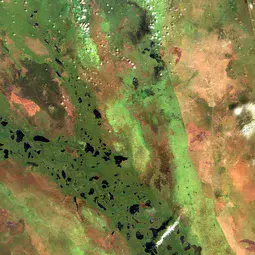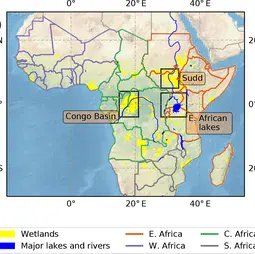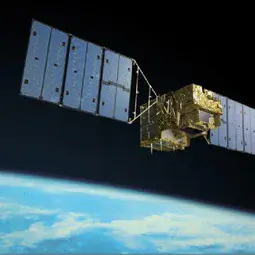One-third of recent global methane increase comes from tropical Africa
11 December 2019
Concentrations of methane, a greenhouse gas about 28 times more potent than carbon dioxide, have risen steadily in Earth’s atmosphere since 2007. Although several potential explanations, including an increase in methane emissions from the tropics, could account for this upsurge, due to a lack of regional data scientists have been unable to pinpoint the source. Now a study published in the European Geosciences Union (EGU) journal Atmospheric Chemistry and Physics uses satellite data to determine that one-third of the global increase originates in Africa’s tropics.
“One of the suggestions for the continued rise in atmospheric methane, based on ground-based data, is that tropical sources have increased,” says Mark Lunt, an atmospheric scientist at the University of Edinburgh and lead author of the study. He and his co-authors used data retrieved from GOSAT, the Japanese Greenhouse gases Observing Satellite, to examine annual—and even seasonal—trends in Africa between the latitudes of 26° N and 26° S.
“There are very few studies that have focused in detail on Africa, primarily because there isn’t much atmospheric methane data from there,” says Lunt. “Using satellite data gives a unique perspective on the continent that wouldn’t otherwise be available.”
Previous studies that have included African methane emission estimates have utilised global models, which are run at relatively coarse resolutions and resolve emission changes at continental scales. By instead focusing exclusively on sub-Saharan Africa, Lunt and his co-authors were able to run a regional model at a much higher resolution than would be feasible with a global version. This difference allowed the researchers to focus on changes in individual countries—a level of detail that could not previously be achieved.
The results indicate that about a third of the global atmospheric methane increase observed between 2010-2016 originates in Africa’s tropics. Most of this came from East Africa, including a pronounced, short-term boost in emissions from the Sudd, one of the world’s largest wetlands, in South Sudan.
“Our research highlights the importance of Africa, and even individual wetlands, in terms of their contributions to the global methane budget,” says Lunt. But, he says, it’s also important to note that the study period only dates back to 2010, the year GOSAT came online. “Based on this work, we cannot say anything about what started the rise in 2007,” says Lunt. The team also cannot yet account for the source of additional increases in methane emissions they observed in East Africa. “Agriculture or other wetlands are likely suspects,” says Lunt, “but we need more evidence to prove this.”
According to Lunt, the findings could be used to improve wetland models, inform where intensive field campaigns should take place to identify the underlying causes of tropical methane emissions, and ultimately help us understand Earth’s future climate. “In order to understand how methane might change in the future, it is essential that we can adequately explain changes in the present and recent past,” says Lunt. “Studies such as this can help narrow down the list of possible explanations, and hopefully improve our predictive capabilities for the future.”
###
Please mention the name of the publication (Atmospheric Chemistry and Physics) if reporting on this story and, if reporting online, include a link to the paper (https://www.atmos-chem-phys.net/19/14721/2019/) or to the journal website (https://www.atmospheric-chemistry-and-physics.net/).
More information
This research is presented in the paper “An increase in methane emissions from tropical Africa between 2010 and 2016 inferred from satellite data” published in the EGU open access journal Atmospheric Chemistry and Physics on 11 December 2019.
The study was conducted by Mark Lunt (School of GeoSciences, University of Edinburgh), Paul Palmer (School of GeoSciences and National Centre for Earth Observation, University of Edinburgh), Liang Feng (School of GeoSciences, and National Centre for Earth Observation, University of Edinburgh), Christopher Taylor (Centre for Ecology and Hydrology and National Centre for Earth Observation, Wallingford), Hartmut Boesch (Earth Observation Science, Department of Physics and Astronomy and National Centre for Earth Observation, University of Leicester), and Robert Parker (Earth Observation Science, Department of Physics and Astronomy and National Centre for Earth Observation, University of Leicester).
Citation: Lunt, M. F., Palmer, P. I., Feng, L., Taylor, C. M., Boesch, H., and Parker, R. J.: An increase in methane emissions from tropical Africa between 2010 and 2016 inferred from satellite data, Atmos. Chem. Phys., 19, 14721-14740, https://doi.org/10.5194/acp-19-14721-2019, 2019.
The European Geosciences Union (EGU) is the leading organisation for Earth, planetary and space science research in Europe. With our partner organisations worldwide, we foster fundamental geoscience research, alongside applied research that addresses key societal and environmental challenges. Our vision is to realise a sustainable and just future for humanity and for the planet. We publish a number of diverse scientific journals, which use an innovative open access format, and organise topical meetings, and education and outreach activities. The annual EGU General Assembly is the largest and most prominent European geosciences event, attracting more than 16,000 scientists from all over the world in 2019. The meeting’s sessions cover a wide range of topics, including volcanology, planetary exploration, the Earth’s internal structure and atmosphere, climate, as well as energy and resources. The EGU General Assembly 2020 is taking in Vienna, Austria, from 3 to 8 May 2020. For information and press registration, please check https://www.egu.eu/gamedia closer to the time of the event, or follow the EGU on Twitter and Facebook.
If you wish to receive our press releases via email, please use the Press Release Subscription Form at https://www.egu.eu/news/subscribe/. Subscribed journalists and other members of the media receive EGU press releases under embargo (if applicable) 24 hours in advance of public dissemination
Atmospheric Chemistry and Physics (ACP) is an international scientific journal dedicated to the publication and public discussion of high-quality studies investigating the Earth’s atmosphere and the underlying chemical and physical processes. It covers the altitude range from the land and ocean surface up to the turbopause, including the troposphere, stratosphere, and mesosphere.
Contact
Researchers
Mark Lunt
Postdoctoral Research Associate
School of GeoSciences
University of Edinburgh
EmailMark.Lunt@ed.ac.uk
Paul Palmer
Professor of Quantitative Earth Observation
School of GeoSciences
University of Edinburgh
Phone+44 (0) 131 650 7724
Emailpip@ed.ac.uk
Press officer
Terri Cook
Head of Media, Communications and Outreach
European Geosciences Union
Munich, Germany
Phone+49-89-2050-76340
Emailmedia@egu.eu
EGU on Twitter: @EuroGeosciences



